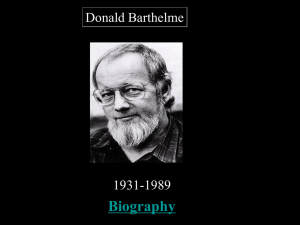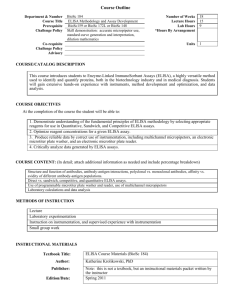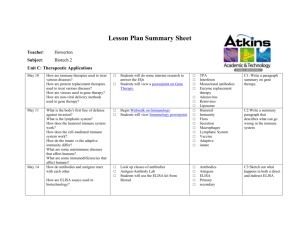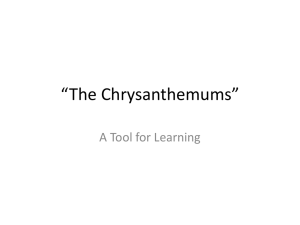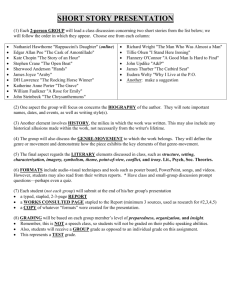File - English 3104: Second Semester 2014-2015
advertisement
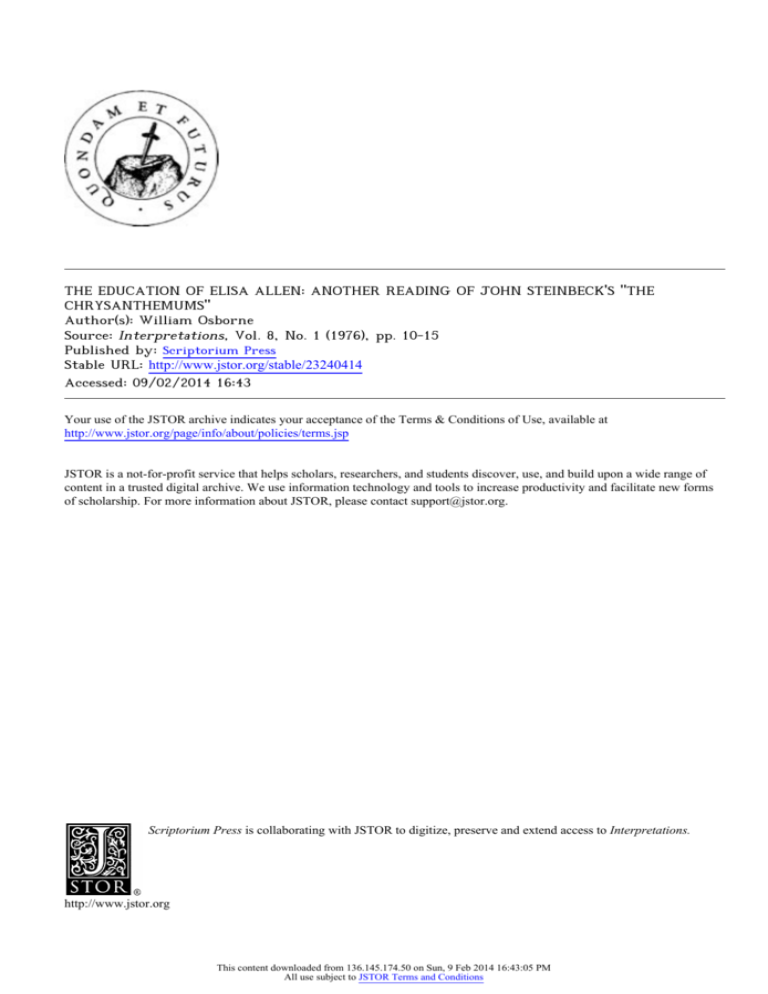
THE EDUCATION OF ELISA ALLEN: ANOTHER READING OF JOHN STEINBECK'S "THE CHRYSANTHEMUMS" Author(s): William Osborne Source: Interpretations, Vol. 8, No. 1 (1976), pp. 10-15 Published by: Scriptorium Press Stable URL: http://www.jstor.org/stable/23240414 . Accessed: 09/02/2014 16:43 Your use of the JSTOR archive indicates your acceptance of the Terms & Conditions of Use, available at . http://www.jstor.org/page/info/about/policies/terms.jsp . JSTOR is a not-for-profit service that helps scholars, researchers, and students discover, use, and build upon a wide range of content in a trusted digital archive. We use information technology and tools to increase productivity and facilitate new forms of scholarship. For more information about JSTOR, please contact support@jstor.org. . Scriptorium Press is collaborating with JSTOR to digitize, preserve and extend access to Interpretations. http://www.jstor.org This content downloaded from 136.145.174.50 on Sun, 9 Feb 2014 16:43:05 PM All use subject to JSTOR Terms and Conditions OF ELISA ALLEN: ANOTHER EDUCATION OF JOHN STEINBECK'S READING "THE CHRYSANTHEMUMS" THE appeared one of John Steinbeck's most In The Long Valley (1938) "The Chrysanthemums." received story, it has nevertheless some of these the interpretations, concerning general highly divergent the nature of Elisa the value of the story and some Allen, concerning and of the variant critics by present readings past protagonist. Typical and popular durable anthology short uncomplicated Seemingly an are offered those Warren Beach and Kenneth Joseph Payson "The of comparison Chrysanthemums" worthy it "arbitrary, and finds self writing,1 Kempton by finds Beach Kempton. with Chekhov's and impelled, unreal."2 Though that as disagreements In Kempton. of these some to resolve The some crucial husband, mutual ... Henry. than alone in the work study, and disagreements of the central an of such will attempt as Beach critics be made and to examine to suggest a reading which might help by the different analyses. posed Beach and Kempton lies in their and her relationship to her personality problems between of dissent of Elisa and arty, muddy, annoyingly one text of the story exists in cannot account for such basic effect more found present area its that reason those the interpretations Allen's "one and finds this relationship of confidence while writes of her "tenseness" (p. 311), Kempton finds her "possibly husband" impotent (p. 123). Beach trait in feminine sees a masculine (p. 311), but Kempton Beach respect" she is with when her refined her fuzzy work it is true today,3 print pieces, and and personality (p. 123). that suggests she may be for "manliness" longing That a frustrated woman both writers Beach Elisa is basically agree. an unsatisfied for some longing way of life less says that she "harbors settled than that of the rancher's wife, something typified by the shabby in the stars" tinker his underneath camping wagon (p. 312). nightly find cannot Kempton and frustration, criticizes in anywhere Steinbeck the for many blind alleys: story leading a source the for reader Elisa's down in one way or another, but is constantly herself [Elisa] defeating know .... why and over what issue only God and Mr. Steinbeck at least, that she longs for something. But whether it is We know, life of the tinker, or the freedom by the nomadic suggested or manliness children by her care of the young plants, symbolized in her strength and her masochistic indicated by her delight sex life hinted at by of her body in the bath, or a normal scrubbing her tenseness with when her possibly or husband, impotent as her merely Ignorant we can't lost of the know youth desire what as that the implied at the end—who her and creates opposes story means (p. 123). can say? frustration, 10 This content downloaded from 136.145.174.50 on Sun, 9 Feb 2014 16:43:05 PM All use subject to JSTOR Terms and Conditions too On the Beach and we contrary, story, will account for the and know and the about agree us what given the and though means, or worth of the meaning for an interpretation that story is requisite of such criticism. Steinbeck novels: romantic what not disparity is one that Chrysanthemums" his stories, plays, sensitive can do Kempton Steinbeck has The theme of "The to use and again in again effect of a utilitarian on the society At the root of Elisa's frustration is the individual. was her of who she is and what her relationship to her society uncertainty should which seems to be a peculiarly modern one. be, a problem Pioneer for example, seldom their identities or women, questioned their value. The combination their child-producing of their scarcity, and potential, Steinbeck their such them value and status. gave in a culture woman in which physical strength Elisa as a post-pioneer has far less value, presents a combination because machines have largely Elisa is childless, has few responsibilities people. a home for her husband, is a vigorous, beyond maintaining intelligent, and romantically sensitive who restlessly woman seeks fulfillment and with a husband who does not particularly need her vigor and identity to begun replace and does not understand her romantic intelligence sensitivity. Like most Elisa intuition a mystical romantics, perceives through between Nature and Man, a perception which she has been relationship unable to communicate to her whose inclinations are husband, utilitarian. in the story he banteringly that thoroughly Early suggests she turn her flower-growing talent to the raising of larger a apples, neither one of them takes very seriously. Her matter-of-fact suggestion about hands that knew how to do it"4 is in response having "planters' remarkable tinker tended the to appeal the "little linked with is most sexual her Fordson" and unchallenging ambivalence romantic later to the explanation Elisa has for so long Thus, real feelings that her behavior appears or ambivalent to the reader. To dramatize her emotion-charged comes up. different us ways of life, Steinbeck provides his covered a man and a way of wagon, restlessness and desire and the for identity; the tinker symbols: which of her her contradictory, to claims of two response with two tractor, 10) and to same subject or disguise her to deny confused, life contrast when Henry and When The in which Elisa's literary pattern dramatized is her unconscious blurring at one moment in a feminine and behaving obviously identity—her and then manner, Beach ones, and unexciting. speaks they in a ruggedly again manner. masculine at the beginning of the story (p. a utilitarian life which was to Elisa mentioned Allen of Elisa's are both feminine traits masculine and for she exemplifies correct, Kempton both and virile of her features. Her gardening apparel is masculine: "Her figure looked blocked and in her gardening heavy her eyes . . (p. 10). her work with the chrysanthemum desire 10). Her stems a man's black hat pulled low down over costume, Her seems masculine: "even energy vigorously was scissors The over-eager, over-powerful. seemed to compete with too small men and shows easy for her energy" (p. a somewhat unfeminine 11 This content downloaded from 136.145.174.50 on Sun, 9 Feb 2014 16:43:05 PM All use subject to JSTOR Terms and Conditions as when she tells the tinker that he might someday have too. And I can beat the dents out of little scissors, sharpen show you what a woman pots. I could might do" (p. 19). The mark of a masculine be her reading about too, might sensibility, extraordinarily aggressiveness, a rival: "I can brutal prize 2.3). Side a fact which fights, as a surprise comes to her husband (p. is a tendency by side with her masculine vigor and aggressiveness romantic Her is apparent daintiness when she femininity. for an evening in town with Henry. She puts on "her newest toward dresses and underclothing of her prettiness. her She and rouged eyebrows, sales she has appeal nicest and dress which was the symbol stockings worked on her hair, her carefully pencilled her lips" When the tinker, whose 20-21). (pp. described resisted, cannily as chrysanthemums being "like a quick puff of colored smoke" (p. 15), Elisa's resistance melts and her to colorful a nice way "What sensitivity language appears. them" for (p. 15), she says, and she is only too glad to prepare several of the slips. Her romantic more is never temperament to describe him than in her description apparent her hands and the tiny plants You watch of the mystical is preparing: union she feels between she work. They do it themselves. You can feel and pick a the buds. never make pick They mistake. with the plant. Do you see? Your They're fingers and the You can feel that, right up your arm. They know. plant. They never make a mistake. You can feel it. When like that you you're can't do anything Do wrong. you see that? Can you understand it how your is. fingers They that? (pp. 17-18). The hands are the she same mentions here ones bent in delicate of wielding capable it is these and hands, pots, ambiguous but now unsheathed and free, heavy gloves and almost touch the trouser-leg of the tinker, her rapturous of the mystical awareness union When the tinker progress of his Her shoulders closed, leaves, caravan: so that she stands with plant and earth to pound dents out of with sometimes sheathed contact a hammer that reach out tentatively shares who, she is certain, between man and nature. as she transported were straight, her head the scene came vaguely the slow watches thrown into back, her eyes half them. Her lips moved silently, forming the words "Good-bye—good-bye." Then she whispered, "That's a bright direction. There's a glowing there." The sound looked In Elisa's ambivalence, of her whisper startled her. She shook free and herself whether had been anyone listening (p. 20). to see relationship and this to her is related husband and the tinker to her uncertainty and there is further confusion 12 This content downloaded from 136.145.174.50 on Sun, 9 Feb 2014 16:43:05 PM All use subject to JSTOR Terms and Conditions about her The relationship to her husband is neither identity. nor as cold as Kempton notes but somewhere suggests extremes. and well, does Henry she possibly as can adroitly, her following Henry vest as ne be "Nice? has came came. You these sensitivity to him feelings to inability with the tinker: very very communicate out of the door, shoving his tie inside his and her face grew tight. Henry at her. "Why—why, Elisa. You look so stiffened looked think as Beach between romantic her conveyed from their experience banging Elisa and Elisa's never inferred blundered Henry understand extraordinary short stopped nice!" not as ideal I look on. nice? "I don't and happy." strong "I am strong? Yes, What know. What strong. do you mean by 'nice'?" I mean you look different, do you mean 'strong'?" He looked bewildered. "You're playing some kind of game," he said break "It's helplessly. a calf over a kind your of a play. knee, watermelon." For You a second didn't she strong," Elisa's tone she know boasted. here is a blend she mentions strength There lost what You happy look enough to strong enough it like a to eat her rigidity. Don't talk like "Henry! She grew complete you said." again. "I never knew before how strong." that. "I'm and admonitory. of the satiric, playful, The is a product of her relationship to the tinker. love interest Elisa and the unkempt between here no is, of course, an oddly platonic accord tinker, except one, engendered by his apparent with her mystical in their relationship The important element musings. is her blind belief that he somehow understands her feelings about nature and shared with and beauty her. Elisa's spirit, feelings sudden burst which no one else has apparently that so surprises of mutual understanding, of self-assurance is the strength that comes of reciprocal of a shared In no other part of the story is she as intimacy. female as she is for a brief time following her experience unambiguously with the tinker. It is during these moments that she puts on her most Henry confidence, feminine of keeping in the curiously and indulges herself feminine practice in last-minute husband while she waiting engages if not literally which true is at least probably still (a practice as such now on the defensive, regarded by men). Henry, apparel her preenings popularly cannot account his idle hat. the car. went strange confidence: and when he toward the tractor shed, "I'll get to her, they were his own again.68 I'm starting." can put on your coat while into the house. She heard him drive to the gate and looked Henry brought out the Elisa for her eyes You down back down his motor, and then she took a long time to put on her it here and pressed it there. When turned pulled Henry motor off she slipped into her coat and went out (p. 22). She 13 This content downloaded from 136.145.174.50 on Sun, 9 Feb 2014 16:43:05 PM All use subject to JSTOR Terms and Conditions of course, is the last time she will will keep waiting. Henry When Elisa discovers that the tinker This, time her in and so confident appear the last she in has not really been interested her feeling and has, about nature, his her of tiny of wagon gift the disillusioned woman we see at the has not really understood flowers, thrown over the side fact, chrysanthemums, end of the story. and an she becomes If she is embittered, she is not without self-knowledge final irony is that Elisa of who she is. Steinbeck's awareness is a romantic into full, if painful, of her identity—she knowledge a utilitarian The who have redeemed other tinker, might society. members a notable was in truth no of her society by being exception, different. He threw away the flowers but kept the pot. His actions ended Elisa's chance of becoming a strong advocate of her way of life, a comes in confident vigorous, a tearful, romantic, words of the story she Instead representative. senile representative who as weakly—like "crying of Steinbeck's reputation an has become old a disabused in the is described woman" final (p. 23). but states as a symbolist, speaks disestablished story we are faced with "conflicting, symbols" and that even the title is of "little help" For the interpretation (p. 123). offered for a title than what Steinbeck here, what could be more relevant Kempton that in this The provided? the for Elisa is ambiguous perfect symbol un that hardy, un-feminine flower, durable, oddly bitter and massiveness and somewhat of its strength chrysanthemum, feminine because smell tough and yet oddly stem comes here, symbolism When the tinker feminine rejected of the flowers preceded It is, of course, an old individual supersensitive it is a flower. too because a fragile, as in many tender bud and bloom From and its strong, The flower. too obvious. Steinbeck is almost stories, Elisa. The death the flowers, he was rejecting the death illusions. of Elisa's of the Steinbeck: the maiming materialistic increasingly society. Almost from his first to his last work he has dramatized it, and in the in the he has handled it neither as well consideration, story under Chekhovian manner as Beach nor as badly in the structural sense avers, as Kempton would have with theme in an it. It is still good Steinbeck. William Osborne Chairman Professor 14 This content downloaded from 136.145.174.50 on Sun, 9 Feb 2014 16:43:05 PM All use subject to JSTOR Terms and Conditions and of English NOTES 1American Fiction, 1920—1940 (New York, 1941), pp. 310-11. Subsequent to this work will be cited in the text. 2Short Stories for Study (Cambridge, will be cited in the text. 1953), p. 124. Subsequent references references to this work 'For an account of the texts of "The Chrysanthemums," see Modern Fiction Studies, 12 (Winter 1966-67), 479-84. The present study will make use of Text 2 referred to in the aforementioned article. See also the useful critical commentary, similar in some respects to the present one, in Marcus Mordecai, "The Lost Dream of Sex and Childbirth in 'The " Modern Fiction Studies, 11 (Spring 1965), 54-58; and Elizabeth E. Chrysanthemums,' " 'The Chrysanthemums': McMahan, Study of a Woman's Sexuality," Modern Fiction Studies, 14 (Winter 1968-69), 453-58. 4John Steinbeck, The Long Valley (Cleveland, work will be cited in the text. 1945). Subsequent references to this 15 This content downloaded from 136.145.174.50 on Sun, 9 Feb 2014 16:43:05 PM All use subject to JSTOR Terms and Conditions
